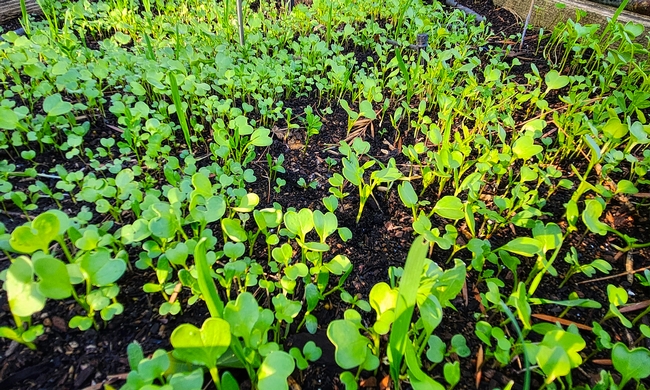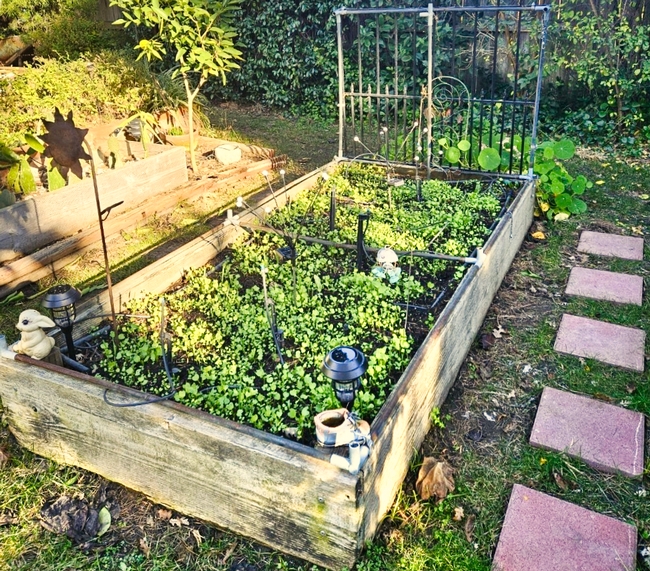- Author: Paula Pashby
In the lastblog, I wrote about my decision to not plant any vegetable plants this winter season. I instead opted to plant cover crops since it was already late in the season, and I have limited time for garden maintenance over the next few months. Plus, cover crops provide other benefits to the soil in my raised garden beds, such as increasing nutrients and organic matter, reducing the chances for erosion, minimizing compaction and improving air circulation, suffocating and suppressing weed growth, AND providing some visually appealing color in the garden throughout winter.
I purchased a mix of organic cover crop seeds and planted these in late-November. Once the seeds were in, we headed out on a road trip to Oregon for some play. When we returned, I was happy to find a full bed of healthy seedlings poking their little green heads out of the soil: What a beautiful sight!
The mix of organic seeds I purchased contains nine varieties of cover crops. I did a little research to better understand the growth cycle of these plants and when they would go to seed. As I noted in my lastblog, I want to avoid having the crop reseed and spread throughout my garden. I discovered that the seed mix will grow and flower simultaneously in a few months, so I can sit back and relax a bit before I even need to think about preparing for the spring season.
Here is a list of the plants that are included in my cover crop mix and some of the benefits they provide to the garden soil:
- Bush Bean – Cowpeas Vigna unguiculata
Family: Fabaceae or Leguminosae (Legumes)
Also known as: black-eye pea, southern pea, niebe and crowder pea
Soil Benefits: adds nitrogen, protects from erosion, and smothers weeds
- Fenugreek Trigonella foenum-graecum
Family: Fabaceae
Also known as: alholva, bird's foot, Greek hay, Greek clover, woo lu bar
Soil Benefits: adds nitrogen
- Millet, Whole Panicum miliaceum
Family: Poaceae, and frequently referred to as the grass family
Also known as: hulled millet, proso millet
Soil Benefits: adds nitrogen, is pest resistant and provides some erosion protection
- Lentil, Sprouting – Red Unhulled Lens culinaris
Family: Fabaceae or Leguminosae (Legumes)
Also known as: Masoor dal
Soil Benefits: adds nitrogen and its firm roots help minimize erosion and suppress weeds
- Oats, Whole Avena sativa
Family: Poaceae and frequently referred to as the grass family
Also known as: groats
Soil Benefits: suppresses weeds, provides organic matter and will absorb any excess nutrients
- Radish, Sprouting Raphanus sativus
Family: Brassicaceae or Cruciferae
Soil Benefits: has long roots that break through the soil and helps subsequent crops to grow deeper roots
- Brown Flax Linum usitatissimum
Family: Linaceae
Also known as: Linseed, Flaxseed and Common Flax
Soil Benefits: adds organic matter andactivates phosphorus
- Mustard
Family: Brassicaceae
Soil Benefits: grows deep roots that loosens up soil, prevents erosion and suppresses weeds
- Turnip – Purple Top White Globe Brassica rapa subsp. rapa
Family: Brassicaceae
Soil Benefits: Similar to mustard, grows deep roots that opens up soil – excellent for improving clay soil
There are many choices when it comes to cover crops. This is just a quick outline of good ones for our local Solano County.
I am looking forward to watching them grow and knowing that they are preparing the soil for spring and summer veggie gardens in the future.





